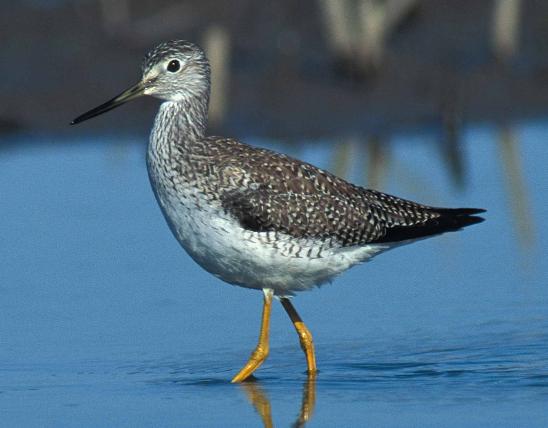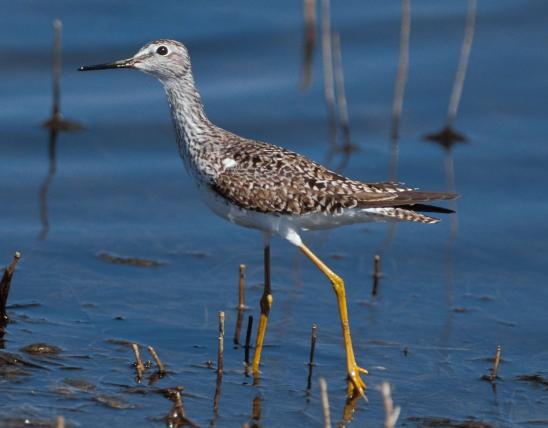
The black-necked stilt is one of Missouri’s easy to identify shorebirds, for its very long, salmon-pink legs and strikingly contrasted black and white plumage. It’s tall for a shorebird, on account of its long legs and neck, but the body itself is fairly small. Adults are black above and white below, with very long pink or red legs. The black bill is slim and straight. The male’s back feathers are glossy black, while the female’s are brownish; immature individuals have light brown edges to the back feathers. The irises of the eyes are red. In flight, black-necked stilts call a loud, brisk “kek, kek, kek!” Most people hear it when they have approached too close to a nest or to young hidden in the vegetation. Black-necked stilts frequently fly in a wide circle around a potential intruder.
Similar species: The American avocet, a larger relative of the black-necked stilt, is a rare migrant in our state and is most frequently seen from western Missouri. It is boldly marked with black and white above (not just black) and white below; the head and neck are rusty during breeding season and gray during nonbreeding season; the legs are grayish (not pink or red); and the bill is upturned (strongly upturned in the female, slightly upturned in the male).
Length: 14 inches.

Statewide as a rare migrant. Rare and local summer resident in southeast Missouri.
Habitat and Conservation
Most Missourians see black-necked stilts during migration, as they forage on mudflats, shorelines, and shallow wastewater lagoons. In summer, these stilts may be seen in the rice fields in the Bootheel’s lowlands.
Food
Forages in shallow water and along shorelines for a wide variety of aquatic invertebrates.
Status
As a transient (spring or fall migrant), rare or casual statewide. As a summer breeding resident, uncommon and local in southeast Missouri.
Life Cycle
Black-necked stilts start arriving in Missouri in late March and are present in the state through the end of October. The migratory populations of black-necked stilts are in the northern parts of the species’ range. These populations spend breeding season in a general range stretching across much of the United States, though mostly in the west. These migrate south to overwinter in the extreme southern United States, Mexico, the Gulf Coast, and the Caribbean.
Farther south, in the rest of the species’ overall range, black-necked stilts do not migrate: these are the ones that live year-round anywhere from South America north to the above-mentioned overwintering range of the migratory stilts. The black-necked stilts in South America and in Hawaii are considered different subspecies than the ones in North America. At times they have been considered separate species.
Like most other shorebirds, black-necked stilts are ground nesters. Both parents participate in nest construction, egg incubation, and rearing the chicks. Choosing some area raised higher than the water level, they scrape a depression into the ground and usually line it with nearby materials such as grass, rocks, and other objects. A clutch comprises 2–5 eggs, which hatch in 24–29 days. There is only one brood a year. As with most other ground-nesting birds, the young are precocial (relatively well-developed): covered with down and able to walk around soon after hatching.
Black-necked stilts usually nest in colonies, and their numbers permit them to defend their nests as a group. When an intruder appears, numbers of adults fly into the air, circling and calling. They may also mislead intruders the way killdeer do, distracting the predator or person away from a nest either by feigning sick or injured behavior or by plopping on the ground as if sitting on a nest, then flying to a further location and pretending again to be on a nest.
Despite a certain degree of cooperative defensive behavior and nesting in the same area, black-necked stilts are still territorial to each other, driving away others of their kind to maintain distance between their nests.
Lifespan can be at least 12 years.
Human Connections
Black-necked stilts have been documented eating large numbers of grasshoppers and weevils, many of which are considered crop pests.
These delicate birds look like they’re wearing tuxedos. Their graceful, purposeful steps convey a sense of dignity and elegance. Their super-long, pink legs remind us of flamingos — a hint of the tropics here in Missouri. By the way, the only birds that have longer legs (proportionate to the body) than stilts are flamingos.
Comparative anatomy is a fascinating study. The bones of different types of animals are essentially very similar, but with different shapes and sizes. In birds, the femur is positioned rather close to the body (think of a chicken thigh); our femurs (thigh bones) are big and long. The long, pink upper part of a stilt’s leg has two bones, the tibia and fibula (think of a chicken drumstick, but longer and thinner); on humans, these are the two long bones between our knees and ankles. Then, the longest, lower portion of a stilt’s leg is called the tarsometatarsus, and it is essentially a stretched-out, fused version of what in humans are the ankle and foot bones (tarsal and metatarsal bones). This is why bird legs seem to bend backward: that isn’t a knee, it’s a heel! A bird’s true knee joint is closer to the body, where the thigh meets the drumstick. There’s even a kneecap (patella); look for it next time you eat chicken.
Ecosystem Connections
Black-legged stilts are predators that eat insects and other small aquatic animals. Thus they help maintain balance in the populations of those animals. Because many small aquatic animals are the larval stages of insects that fly around in the air, animals that eat the larvae — before they can reproduce — have a large impact on those populations.
A variety of animals prey on these ground-nesting birds and their eggs and young. The elaborate defensive strategies — ranging from raucous swirling mayhem, to distraction displays, to outright harassment of intruders — remind us how vulnerable the eggs, young, and overworked, nesting parents are to predation.


















About 350 species of birds are likely to be seen in Missouri, though nearly 400 have been recorded within our borders. Most people know a bird when they see one — it has feathers, wings, and a bill. Birds are warm-blooded, and most species can fly. Many migrate hundreds or thousands of miles. Birds lay hard-shelled eggs (often in a nest), and the parents care for the young. Many communicate with songs and calls.


























